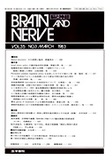Japanese
English
- 有料閲覧
- Abstract 文献概要
- 1ページ目 Look Inside
抄録 低酸素細胞の放射線増感剤であるmisonidazoleの腫瘍局所投与について検討した。silicone rub—ber,silicone tubeを川いてmisonidazoleのpelletを作製し,in vitroで生理食塩水中にpelletから放出されるmisonidazoleの濃度を測定したところ,約1カ月にわたり持続的にmisonidazoleがpelletから放出されることが確認された。ラットの皮下腫瘍にpelletを留置した場合は,in vitroの実験で予想されるほど高濃度のrnisonidazoleは腫瘍内からは検出されなかったが,4週間にわたりmisonidazoleが腫内に認められた。misonidazoleの頭蓋内腫瘍への局所投与において問題となるのはneurotoxicityであるが,マウスの頭蓋内,ラットの大槽内投与では0.6mgまで投与して経過を観察したが異常は認められなかった。また,犬の頭蓋内にpelletを留置し経過を観察したが,0.5gのmisonidazoleを含むpelletでは異常は認められなかった。以上の実験に基づき,脳腫瘍患者3例に,腫瘍摘出腔内にmisonidazole pelletを留置して放射線治療を行なったが,3〜7カ月の観察期間中の経過は良好である。
Local administration of hypoxic cell radiosensiti-zer misonidazole was studied. Misonidazole pellets were made with silastic medical-grade elastomer (Dow Corning), (peon ss No. 4 silicone tube (Fuji system), A. No. 10 silicone tube (Dow Corning) and diffusion of misonidazole from these pellets was examined.
When the pellet made with silastic medical-grade elastomer containing 1 g of misonidazole was pla-ced in 2.0 ml of normal saline every 24 hours, it released a large dosis of misonidazole into the saline at 37℃ for first 2 days, but it released about 6-8 mg/day of misonidazole constantly after the 3rd day. When the same pellet was placed in 2.0 ml of normal saline every week, it released 15-20 mg/week of misonidazole into the saline at 37℃ for 4 weeks.
When the pellet made with (peon ss No. 4 sili-cone tube containing 0.5 g of misonidazole was placed in 2.0 ml of normal saline every 3 days, it released 330-400 Lig/3 days of misonidazole into the saline at 37℃ for 30 days. When the pellet made with A. No. 10 silicone tube containing 2 g of misonidazole was placed in 10 ml of normal saline every week, it released 2.7-3.3 mg/week of miso-nidazole into the saline at 37℃ for 4 weeks. When the pellet was placed in the same saline, 3.2 mg of misonidazole was detected after a week, and then the concentration of misonidazole in the sa-line gradually increased and 4 weeks later 11.0 mg of misonidazole was detected.
In these in vitro examinations, the pellet made with silastic medical-grade elastomer released much more misonidazole than those made with sili-cone tubes and the concentration of misonidazole released into the saline was much higher than the serum concentration obtained by the oral admi-nistration of misonidazole. In in vivo examination, the release of misonidazole from the pellet placed in the subcutaneous tumor in rats was observed for 4 weeks. But the concentration of rnisonida-zole was not so high as had been expected fromthe data in in vitro experiments. This may be due to the dilution of misonidazole by tissue fluid and the technical problems in obtaining appropriate specimens.
In case of intracranial administration of miso-nidazole, the neurotoxicity of misonidazole must be taken into account. When 0. 6 mg of misonida-zole was injected into subarachnoid space in rats or intracranially in mice, no convulsion and no other neurological findings were observed. When the pellet containing 0. 5 g of misonidazole was placed intracranially in dogs, no convulsion and no other neurological findings were observed in a period of 7-37 days.
In view of the constant release of misonidazolefrom the pellet into the tumor, its direct cyto-toxic effect and the lack of side effects, a clinical trial to place the misonidazole pellet in the tumor bed was attempted. Three patients (a 67-year-old female with brain metastasis from uterine can-cer, a 44-year-old male with glioblastoma and a 44-year-old female with astrocytoma) have been treated by the local application of misoni-dazole pellet into the tumor bed as an adjunct to radiotherapy. Although it is too early to make a conclusion, there have been no remarkable side effects and all of them have had an uneventful clinical course for 3-7 months.

Copyright © 1983, Igaku-Shoin Ltd. All rights reserved.


